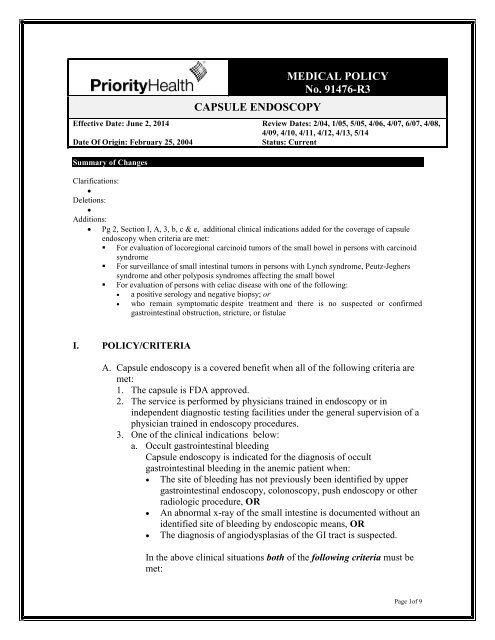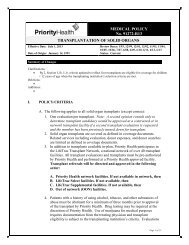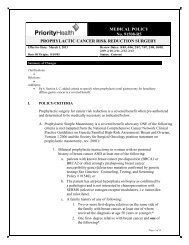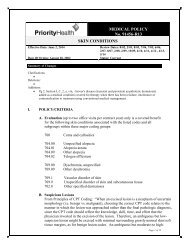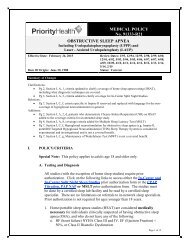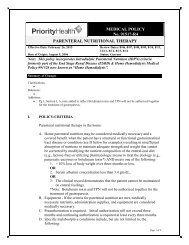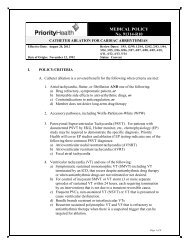Capsule Endoscopy - 91476 - Priority Health
Capsule Endoscopy - 91476 - Priority Health
Capsule Endoscopy - 91476 - Priority Health
You also want an ePaper? Increase the reach of your titles
YUMPU automatically turns print PDFs into web optimized ePapers that Google loves.
CAPSULE ENDOSCOPYMEDICAL POLICYNo. <strong>91476</strong>-R3Effective Date: June 2, 2014 Review Dates: 2/04, 1/05, 5/05, 4/06, 4/07, 6/07, 4/08,4/09, 4/10, 4/11, 4/12, 4/13, 5/14Date Of Origin: February 25, 2004Status: CurrentSummary of ChangesClarifications:•Deletions:•Additions:• Pg 2, Section I, A, 3, b, c & e, additional clinical indications added for the coverage of capsuleendoscopy when criteria are met:• For evaluation of locoregional carcinoid tumors of the small bowel in persons with carcinoidsyndrome• For surveillance of small intestinal tumors in persons with Lynch syndrome, Peutz-Jegherssyndrome and other polyposis syndromes affecting the small bowel• For evaluation of persons with celiac disease with one of the following:• a positive serology and negative biopsy; or• who remain symptomatic despite treatment and there is no suspected or confirmedgastrointestinal obstruction, stricture, or fistulaeI. POLICY/CRITERIAA. <strong>Capsule</strong> endoscopy is a covered benefit when all of the following criteria aremet:1. The capsule is FDA approved.2. The service is performed by physicians trained in endoscopy or inindependent diagnostic testing facilities under the general supervision of aphysician trained in endoscopy procedures.3. One of the clinical indications below:a. Occult gastrointestinal bleeding<strong>Capsule</strong> endoscopy is indicated for the diagnosis of occultgastrointestinal bleeding in the anemic patient when:• The site of bleeding has not previously been identified by uppergastrointestinal endoscopy, colonoscopy, push endoscopy or otherradiologic procedure, OR• An abnormal x-ray of the small intestine is documented without anidentified site of bleeding by endoscopic means, OR• The diagnosis of angiodysplasias of the GI tract is suspected.In the above clinical situations both of the following criteria must bemet:Page 1of 9
MEDICAL POLICYNo. <strong>91476</strong>-R3<strong>Capsule</strong> <strong>Endoscopy</strong>3. To document adequacy of PPI therapy in esophageal acid control inindividuals with complications of reflux disease that include Barrett’sesophagus4. To evaluate endoscopy-negative individuals with atypical refluxsymptoms that are refractory to twice per day PPI therapy5. To evaluate individuals after anti-reflux surgery who are suspected to haveongoing abnormal reflux and have not responded to empiric trials of PPItherapyD. Wireless esophageal pH monitoring is considered experimental,investigational or unproven for these indications:1. To detect or verify reflux esophagitis2. To evaluate for “alkaline reflux”II.MEDICAL NECESSITY REVIEWRequired Not Required Not ApplicableIII.APPLICATION TO PRODUCTSCoverage is subject to member’s specific benefits. Group specific policy willsupersede this policy when applicable. HMO/EPO: This policy applies to insured HMO/EPO plans. POS: This policy applies to insured POS plans. PPO: This policy applies to insured PPO plans. Consult individual plan documents asstate mandated benefits may apply. If there is a conflict between this policy and a plandocument, the provisions of the plan document will govern. ASO: For self-funded plans, consult individual plan documents. If there is a conflictbetween this policy and a self-funded plan document, the provisions of the plan documentwill govern. INDIVIDUAL: For individual policies, consult the individual insurance policy. If there isa conflict between this medical policy and the individual insurance policy document, theprovisions of the individual insurance policy will govern. MEDICARE: Coverage is determined by the Centers for Medicare and Medicaid Services(CMS); if a coverage determination has not been adopted by CMS, this policy applies. MEDICAID: For Medicaid members, this policy will apply. Coverage is based on medicalnecessity criteria being met and the appropriate code(s) from the coding section of thispolicy being included on the Michigan Medicaid Fee Schedule located at:http://www.michigan.gov/mdch/0,1607,7-132-2945_42542_42543_42546_42551-159815--,00.html. If there is a discrepancy between this policy and the Michigan Medicaid ProviderManual located at: http://www.michigan.gov/mdch/0,1607,7-132-2945_5100-87572--,00.html, the Michigan Medicaid Provider Manual will govern. For MedicalSupplies/DME/Prosthetics and Orthotics, please refer to the Michigan Medicaid FeeSchedule to verify coverage. MICHILD: For MICHILD members, this policy will apply unless MICHILD certificate ofcoverage limits or extends coverage.Page 3 of 9
MEDICAL POLICYNo. <strong>91476</strong>-R3<strong>Capsule</strong> <strong>Endoscopy</strong>IV.DESCRIPTIONWireless capsule endoscopy (WCE), a noninvasive procedure in which aswallowable, multivitamin-sized capsule containing a miniaturized video camera,light, transmitter, and batteries takes a video recording of the mucosal lining ofthe small bowel as it moves through the gastrointestinal (GI) tract. The videoimages are transmitted to sensors taped to the body and stored on a portablerecorder. The strength of the signal is used to calculate the position of the capsuleas it passes through the GI tract. Video images are stored on a portable recorderand later downloaded to computer, from which they may be viewed. The capsulepasses naturally from the body with the stool, and since it is disposable, is notrecovered.Background:A procedure known as wireless capsule endoscopy (WCE) or capsule endoscopyhas been developed for the noninvasive visualization of suspected small-bowelabnormalities. For this test, a specially designed, ingestible capsule captures andrecords images as it travels through the GI tract. Before swallowing the capsule,the patient is fitted with the belt holding the data recorder and the battery pack,and a sensor array is attached to the abdomen. During imaging, the patient is ableto leave the clinic and resume normal activities. After 6 to 8 hours, or in noticingthat the capsule has been excreted, the patient returns the belt and data recorder tothe clinic or office for processing and evaluation. The test is intended for patientswith chronic or recurrent GI bleeding of unknown etiology and other GIsymptoms who have negative findings on upper GI endoscopy, colonoscopy, andother tests. WCE was initially approved by the Food and Drug Administration(FDA) in August 2001 for use as an adjunct to standard procedures for diagnosingsuspected abnormalities of the small bowel. In July 2003, the device was clearedfor use as a first-line tool in diagnosing small-bowel disease.In August 2001, the FDA cleared for marketing a swallowable capsule containinga small camera that snaps pictures twice a second as it passes through the smallintestine. The FDA classified the capsule, called the Given Diagnostic ImagingSystem (Given Imaging Ltd., Yoqneam, Isreal), as a Class II device that is subjectonly to general regulatory controls. The capsule has a clear end that allows thecamera to view the lining of the small intestine. In addition to the camera, thewireless capsule, about the size of a grape, contains a lighting system and atransmitter that will send images from inside the intestine to video monitors,allowing doctors to detect sources of bleeding in the small intestine. FDA clearedthe device for use along with, not as a replacement for, other endoscopic andradiological evaluations of the small intestine. The capsule was not studied in thelarge intestine.Page 4 of 9
MEDICAL POLICYNo. <strong>91476</strong>-R3<strong>Capsule</strong> <strong>Endoscopy</strong>When swallowed, the device travels down the digestive tract at about the samespeed as food, propelled by peristalsis, and takes two to three hours to passthrough. Once the device reaches the colon, things slow down, and the disposabledevice is eliminated like any solid waste within a few days.The downside to this technology is that the images may not match fiber-opticendoscopes for detail, and concerns have been raised that the camera's view maybe obscured by bubbly saliva or green bile. The capsule cannot be stopped orsteered to collect close-up details of the small intestine's millions of interiorwrinkles where ailments often occur. Nor is it fitted with surgical tools like aconventional endoscope to take biopsies or treat bleeding lesions or removepolyps. If a lesion requiring invasive therapy is found on capsule endoscopy, thenthe patient will need to undergo surgery with intraoperative endoscopy. Inaddition, if an abnormality is seen on capsule endoscopy, there is no good way todefine its location within the small intestine.<strong>Capsule</strong> endoscopy has not been proven to be of value in detecting conditions inthe esophagus or colon. The esophageal transit time of the capsule is brief (lessthan 5 seconds) when patients ingest the capsule with water in the uprightposition. The transit time may be lengthened by having the patient ingest thecapsule lying horizontally.The colon is not well visualized with capsule endoscopy because stool obscuresthe visualization of the colonic mucosa. Visualization of the colon is moredifficult than the small intestine because of its slower transit time and largerdiameter; it is possible for the camera to miss suspicious areas of the colon simplyby being pointed in the wrong direction. An American Cancer Society positionstatement (Levin, et al., 2003) has concluded that there is no evidence to supportthe use of capsule endoscopy for detecting colorectal polyps or cancers.<strong>Capsule</strong> endoscopy is contraindicated in patients with obstruction of thegastrointestinal tract. The available literature indicates that an uppergastrointestinal series should be performed prior to capsule endoscopy if thepatient is suspected of having intestinal obstruction.There is some evidence from several comparative clinical trials and case seriesthat WCE can provide useful diagnostic information in carefully selected patientswith documented, chronic occult or obscure GI bleeding of suspected small-bowelorigin or for patients with other chronic GI symptoms suggestive of small-boweldisease who have negative or indeterminate findings on standard tests. Moreover,some studies have reported that patients who are treated based on WCE resultsdemonstrate clinical improvement, although long-term health outcomes areunknown due to inadequate follow-up times. Therefore, WCE has the potential toimprove the health outcomes of selected patients whose diagnoses remainunknown or indeterminate following standard endoscopic and imagingevaluations. However, despite these promising findings, definitive conclusionsPage 5 of 9
MEDICAL POLICYNo. <strong>91476</strong>-R3<strong>Capsule</strong> <strong>Endoscopy</strong>regarding the appropriate clinical role for WCE cannot be made due to limitationsin study design and execution. There is a need for additional larger, well-designedtrials that compare the findings of WCE with an adequate reference standard ofdiagnosis so that the diagnostic accuracy of this technology can be determined.The effect of WCE on clinical decision-making requires systematic evaluation inorder to determine its optimal clinical role in the general healthcare setting and toidentify which patients would benefit from this procedure.Wireless esophageal pH monitoring involves the temporary attachment of a small,capsular device to the distal esophagus. This capsule contains a miniaturized pHelectrode and broadcasting system that enables measurement of esophageal pHand wireless transmission of pH data to an external data recorder. Records ofesophageal pH are subsequently downloaded to a computer for analysis. The goalof this procedure is to assess esophageal exposure to gastric acid and determine ifthe patient has gastroesophageal reflux disease (GERD) or a related disorder.V. CODING INFORMATION:ICD-9 Codes that apply to this policy (for dates of service on or before September 30, 2015):Procedure 91110 only covered for the following diagnoses when criteria listed above is met.152.0-152.9 Malignant neoplasm of small intestine, including duodenum235.2 Neoplasm of uncertain behavior-stomach, intestines and rectum259.2 Carcinoid syndrome280.0 Iron deficiency anemia secondary to blood loss (chronic)280.9 Iron deficiency anemia, unspecified285.9 Unspecified anemia537.82 Angiodyosplasia of stomach and duodenum intestine withoutmention of hemorrhage537.83 Angiodyosplasia of stomach and duodenum intestine withhemorrhage555.0 Regional enteritis of small intestine555.1 Regional enteritis of large intestine555.2 Regional enteritis of small intestine with large intestine555.9 Regional enteritis of unspecified site558.9 Other and unspecified noninfectious gastroenteritis and colitis562.02 Diverticulosis of small intestine with hemorrhage562.03 Diverticulitis of small intestineDiverticulitis of small intestine withhemorrhage569.82 Ulceration of intestine569.84 Angiodyosplasia of intestine without mention of hemorrhage569.85 Angiodysplasia of intestine with hemorrhagePage 6 of 9
MEDICAL POLICYNo. <strong>91476</strong>-R3<strong>Capsule</strong> <strong>Endoscopy</strong>578.1 Blood in stool578.9 Unspecified, hemorrhage of gastrointestinal tract579.0 Celiac disease792.1 Nonspecific abnormal finding in stool contents793.4 Nonspecific abnormal findings on radiological and otherexamination of body structure, gastrointestinal tractICD-10 Codes that apply to this policy (for dates of service on or after October 1, 2014):Procedure 91110 only covered for the following diagnoses when criteria listed above is met.C17.0 - C17.9 Malignant neoplasm of small intestineD37.1 - D37.5 Neoplasm of uncertain behavior of digestive organsD50.0 Iron deficiency anemia secondary to blood loss (chronic)D50.9 Iron deficiency anemia, unspecifiedD64.9 Anemia, unspecifiedE34.0 Carcinoid syndromeK31.811 Angiodysplasia of stomach and duodenum with bleedingK31.819 Angiodysplasia of stomach and duodenum without bleedingK50.00 – K50.919 Crohn's disease of small intestine without complicationsK52.89 Other specified noninfective gastroenteritis and colitisK52.9 Noninfective gastroenteritis and colitis, unspecifiedK55.20 Angiodysplasia of colon without hemorrhageK55.21 Angiodysplasia of colon with hemorrhageK57.01 Diverticulitis of small intestine with perforation and abscess withbleedingK57.11 Diverticulosis of small intestine without perforation or abscesswith bleedingK57.13 Diverticulitis of small intestine without perforation or abscess withbleedingK57.41 Diverticulitis of both small and large intestine with perforation andabscess with bleedingK57.51 Diverticulosis of both small and large intestine without perforationor abscess with bleedingK57.53 Diverticulitis of both small and large intestine without perforationor abscess with bleedingK63.3 Ulcer of intestineK90.0 Celiac diseaseK92.1 MelenaK92.2 Gastrointestinal hemorrhage, unspecifiedR19.5 Other fecal abnormalitiesR93.3 Abnormal findings on diagnostic imaging of other parts ofdigestive tractCPT HCPCS Code:91110 Gastrointestinal tract imaging, intraluminal (e.g., capsule endoscopy),esophagus through ileum, with physician interpretation and report91034 Esophagus, gastroesophageal reflux test; with nasal catheter pH electrode(s)placement, recording, analysis and interpretationPage 7 of 9
MEDICAL POLICYNo. <strong>91476</strong>-R3<strong>Capsule</strong> <strong>Endoscopy</strong>91035 Esophagus, gastroesophageal reflux test; with mucosal attached telemetry pHelectrode placement, recording, analysis and interpretationNot Covered:91111 Gastrointestinal tract imaging, intraluminal (eg, capsule endoscopy), esophaguswith physician interpretation and report91112 Gastrointestinal transit and pressure measurement, stomach through colon,wireless capsule, with interpretation and report0355TGastrointestinal tract imaging, intraluminal (eg, capsule endoscopy), colon,with interpretation and report (Effective July 1, 2014)VI.REFERENCES“WPS Medicare Part B-GI-009 Telemetric Gastrointestinal <strong>Capsule</strong> Imaging”Available on the World Wide Web at http://www.wpsic.com/cgibin/polsearchil.cgi(Retrieved December 30, 2003). Updated version11/01/04 @ http://www.wpsic.com/medicare/policies/illinois/gi09.shtml(Retrieved March 21, 2005).“Wireless <strong>Capsule</strong> <strong>Endoscopy</strong>” HAYES, Inc. November 2003. Updated SearchDecember 2004.“<strong>Capsule</strong> <strong>Endoscopy</strong>” Aetna Clinical Policy Bulletins, Number 0588, April 25,2003, November 2005, December 24, 2013).http://www.aetna.com/cpb/data/CPBA0588.html. (Retrieved December 30,2003, February 14, 2006, March 2014).“Wireless <strong>Capsule</strong> <strong>Endoscopy</strong>”, Blue Cross Blue Shield Massachusetts, PolicyNumber 7, October 2003. Available on the World Wide Web athttp://www.bcbsma.com/common/en_US/medical_policies/007.htm#scientific. (Retrieved December 30, 2003).“Wireless Esophageal pH monitoring” HAYES, Inc. Medical TechnologyDirectory, May 2008, Updated May 2009.Aetna Clinical Policy Bulletin:Esophageal/Airway pH Monitoring #0667- 11/20/2009. Accessed February26, 2010.Cigna Medical Coverage Policy: Wireless esophageal pH monitoring ) #0329-4/15/2009. Accessed February 26, 2010.Rokkas T, Niv Y. The role of videocapsule endoscopy in the diagnosis of celiac disease: A meta-analysis. Eur JGastroenterol Hepatol. 2012;24(3):303-308.Saurin JC, Pilleul F, Soussan EB, et al.; <strong>Capsule</strong> Commission of the FrenchSociety of Digestive <strong>Endoscopy</strong> (SFED). Small-bowel capsule endoscopydiagnoses early and advanced neoplasms in asymptomatic patients withLynch syndrome. <strong>Endoscopy</strong>. 2010;42(12):1057-1062.Page 8 of 9
MEDICAL POLICYNo. <strong>91476</strong>-R3<strong>Capsule</strong> <strong>Endoscopy</strong>AMA CPT Copyright Statement:All Current Procedure Terminology (CPT) codes, descriptions, and other data are copyrighted by theAmerican Medical Association.This document is for informational purposes only. It is not an authorization, certification, explanation ofbenefits, or contract. Receipt of benefits is subject to satisfaction of all terms and conditions of coverage.Eligibility and benefit coverage are determined in accordance with the terms of the member’s plan in effectas of the date services are rendered. <strong>Priority</strong> <strong>Health</strong>’s medical policies are developed with the assistanceof medical professionals and are based upon a review of published and unpublished information including,but not limited to, current medical literature, guidelines published by public health and health researchagencies, and community medical practices in the treatment and diagnosis of disease. Because medicalpractice, information, and technology are constantly changing, <strong>Priority</strong> <strong>Health</strong> reserves the right to reviewand update its medical policies at its discretion.<strong>Priority</strong> <strong>Health</strong>’s medical policies are intended to serve as a resource to the plan. They are not intended tolimit the plan’s ability to interpret plan language as deemed appropriate. Physicians and other providersare solely responsible for all aspects of medical care and treatment, including the type, quality, and levelsof care and treatment they choose to provide.The name “<strong>Priority</strong> <strong>Health</strong>” and the term “plan” mean <strong>Priority</strong> <strong>Health</strong>, <strong>Priority</strong> <strong>Health</strong> Managed Benefits,Inc., <strong>Priority</strong> <strong>Health</strong> Insurance Company and <strong>Priority</strong> <strong>Health</strong> Government Programs, Inc.Page 9 of 9


